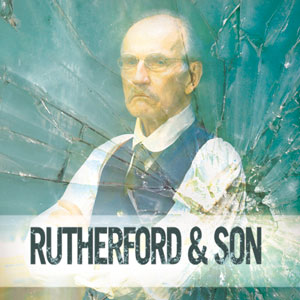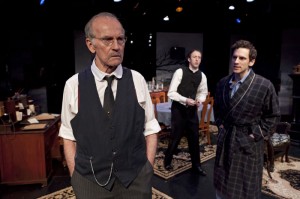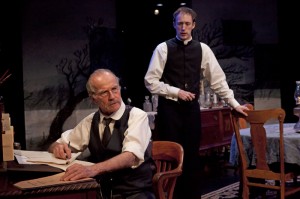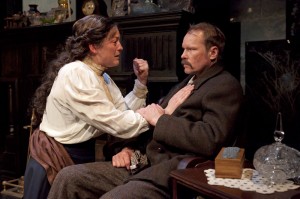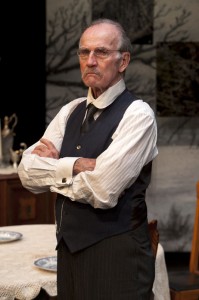MINT ACTING IN RUTHERFORD & SON
The Mint Theater Company’s mission is to “excavate buried theatrical treasures” and bring “new vitality to neglected plays.” No small task as plays usually go out of fashion for a reason; theatrical styles change, the zeitgeist renders them irrelevant, and the avant garde becomes the norm until it becomes passé. Play selection itself is always a challenge for the Mint as their mission statement demands scrutiny to see if the excavated play actually is worthy of a production. Rutherford & Son, the Mint Theater Company’s current production, is not the Mint’s first production of Githa Sowerby’s 1912 play; it was also part of their 2001-2002 season. While the play itself is a bit dusty, the acting opportunities it offers more than justify two productions.
Today, Rutherford & Son is more a theatre history curiosity than an enduring work of dramatic literature. The story of a ruthless father who sacrifices his three children for his huge glassworks in England’s industrial north was a big hit when it opened at the Royal Court in 1912. In her day, Sowerby was compared to Ibsen. Today, in the shadow of Hillary Clinton, Michele Bachmann, and Sarah Palin, a play that explores the consequences of women aspiring to roles outside the home seems little more than quaint. In addition, Rutherford & Son is Sowerby’s first play; it lacks both structural coherence and is overwritten even by the standards of its day – hence, its neglect.
And yet, so much of the play is deliciously act-able, which is the joy of this current production. The Mint Theater Company has assembled a terrifically talented group who gamely embrace Sowerby’s play. As John, the vulnerable Rutherford son with a game-changing invention, Eli James orchestrates a fine performance with such strong acting chops that he earns the audience’s sympathies even in the play’s most melodramatic silliness. Likewise, James Patrick Nelson plays the clerical son Richard with a lovely balance of compassion for humanity and rebellion against an abusive father.
The performance of the night, however, belongs to Sara Surrey as Janet Rutherford, the long-suffering sister who is over-the-hill at 36, fearless in her love for working-class Martin, and willing to make the greatest sacrifice for the greater good. Surrey is the kind of actress who silently fills the stage with her rich inner life, reveals emotions like petals of a blossoming flower, and when she does open her mouth, she speaks with such soulful truth that the audience literally cheers for her when she confronts her cruel father, bringing down the second act curtain.
The lesser roles are also well cast with some of New York’s finest underappreciated character actors. Sandra Shipley as Aunt Ann keeps the exposition moving forward with stoic humor as she gets laughs delivering lines about their “plain and lasting” family values. Dale Soules as Mrs. Henderson, a mother throwing herself at Mr. Rutherford’s mercy on behalf of her ne’er-do-well son, is perfectly funny, feisty, and not above hurling a nasty insult as an exit line. David Van Peldt plays blue-collar Martin with such detailed veracity in both dialect and appearance that he seems to have stepped out of 1912.
In fact, the only weak performance is by Robert Hogan as the patriarchal John Rutherford. The play revolves around children rebelling against a despotic father. Hogan’s instincts as an actor have him playing Rutherford with such detachment that he never becomes the formidable vortex to be feared at the play’s center. Because the other actors are so completely engaging in their roles, his miscasting doesn’t stand a chance of marring the evening.
The other missteps are in direction and design. Vicki R. Davis’ set feels cluttered with excessive decorative glass panels depicting nature. While there may be some symbolic connection to Darwin, nature and Rutherford’s glassworks, the set feels more like a fussy interior design showroom than a living room. I can’t credit director Richard Corey with much more than guiding lovely actors towards great work. His production speaks no relevance to the contemporary American cultural conversation. My biggest fear when attending Mint Theater Company productions is that the work is better suited for a museum than a theatre. Corey’s direction regretfully falls into that trap. What a relief that that the current production of Rutherford & Son is gloriously well acted!
photos by Richard Termine
Rutherford & Son
Mint Theater Company
ends on April 7, 2012
for tickets, visit Mint Theatre
